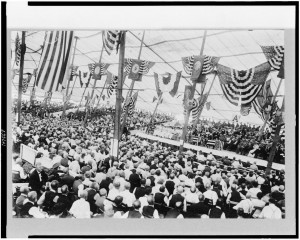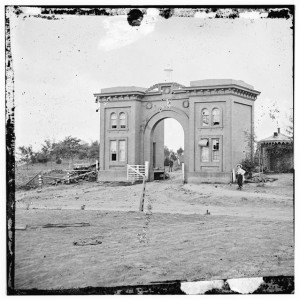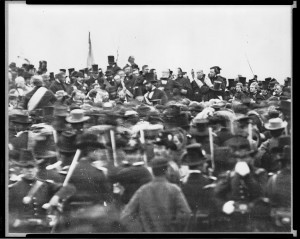Flags surrounded Gettysburg Address
By James Breig

Seven score and ten years have rolled by since Nov. 19, 1863, when the most famous speech in American history was delivered by President Abraham Lincoln in Gettysburg, Pa. Pressed in by a crowd eager to hear his remarks and surrounded by flapping flags, the Great Emancipator intoned the immortal words: “Four score and seven years ago….”
The occasion was the dedication of a national cemetery to bury those who had given their lives to save the Union during the vicious July 1-3, 1863, fighting in Gettysburg.

Describing the stand from which Lincoln spoke, The New York Times recorded that “numerous flags and banners, suitably draped, were exhibited….The entire scene was one of grandeur due to the importance of the occasion.” A tall flagpole that stood near Lincoln marked the center of the nascent cemetery.

Many flags flew throughout the town of Gettysburg, where every public building and many private homes displayed an American flag at half-staff. That act of patriotism and mourning was imitated in many northern cities. In Hartford, Connecticut, for example, a newspaper observed that Nutmeg State soldiers “lie entombed [at Gettysburg]….No fitter tribute can be paid than by displaying the glorious flag beneath which they gave up their lives. Let the Stars and Stripes be flung to the breeze…in every part of the city.”
Preceding Lincoln’s brief remarks, Edward Everett, who was considered America’s preeminent orator, spoke for two hours. He referenced the U.S. flag when speaking of the South: “The weary masses of the people [there] are yearning to see the dear old flag again floating upon their capitols, and they sigh for the return of the peace, prosperity, and happiness which they enjoyed under a government whose power was felt only in its blessings.”
Next, the president spoke, taking only two minutes to deliver his Gettysburg Address but eliciting applause on several occasions, including after these words: “We here highly resolve that the dead shall not have died in vain.”
Later in the afternoon, a regiment of New York soldiers passed in review before the governor of New York, Horatio Seymour, who had attended the Gettysburg ceremonies. He presented the troops with “a handsome silk regimental standard,” the Times noted, and said: “I ask in return of the men of New York to give three cheers for the Union of our country, and three cheers for the flag of our land.”
